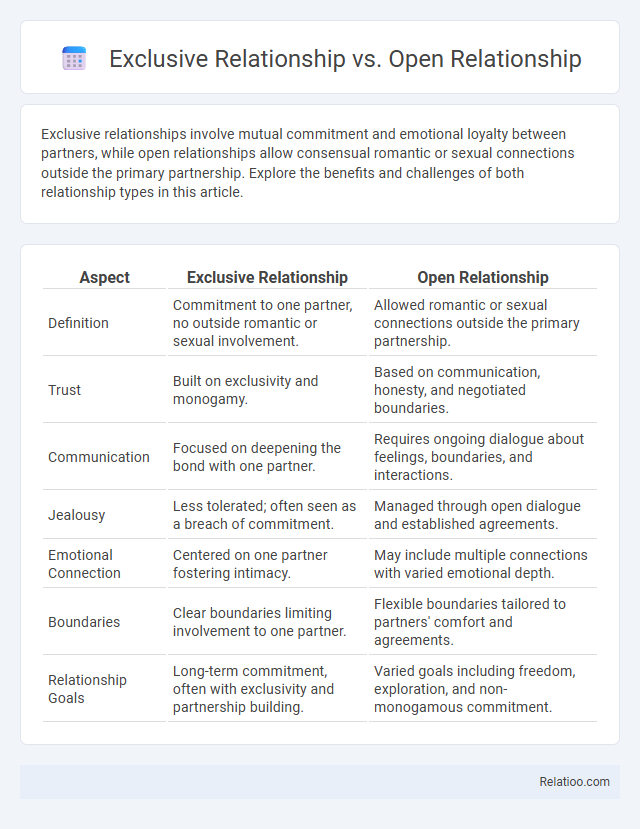Exclusive relationships involve mutual commitment and emotional loyalty between partners, while open relationships allow consensual romantic or sexual connections outside the primary partnership. Explore the benefits and challenges of both relationship types in this article.
Table of Comparison
| Aspect | Exclusive Relationship | Open Relationship |
|---|---|---|
| Definition | Commitment to one partner, no outside romantic or sexual involvement. | Allowed romantic or sexual connections outside the primary partnership. |
| Trust | Built on exclusivity and monogamy. | Based on communication, honesty, and negotiated boundaries. |
| Communication | Focused on deepening the bond with one partner. | Requires ongoing dialogue about feelings, boundaries, and interactions. |
| Jealousy | Less tolerated; often seen as a breach of commitment. | Managed through open dialogue and established agreements. |
| Emotional Connection | Centered on one partner fostering intimacy. | May include multiple connections with varied emotional depth. |
| Boundaries | Clear boundaries limiting involvement to one partner. | Flexible boundaries tailored to partners' comfort and agreements. |
| Relationship Goals | Long-term commitment, often with exclusivity and partnership building. | Varied goals including freedom, exploration, and non-monogamous commitment. |
Defining Exclusive and Open Relationships
An exclusive relationship involves a mutual agreement where both partners commit to emotional and physical fidelity, ensuring trust and clarity in their bond. Open relationships allow partners to engage with others sexually or romantically outside the partnership, emphasizing communication and consent to maintain respect and boundaries. Understanding the distinctions between exclusivity and openness helps You navigate personal expectations and relationship dynamics effectively.
Core Principles of Each Relationship Type
Exclusive relationships prioritize mutual commitment, emotional fidelity, and a shared agreement to engage solely with each other romantically and sexually. Open relationships emphasize consensual non-monogamy, where partners agree to explore romantic or sexual connections outside their primary bond while maintaining honesty and communication. Exclusivity centers on the boundary-setting framework that defines the level of emotional and physical commitment, varying from complete monogamy to negotiated openness based on trust and agreed-upon rules.
Communication Dynamics in Both Relationships
Communication dynamics in exclusive relationships prioritize clear boundaries and emotional commitment, fostering trust and consistent dialogue between partners. Open relationships require ongoing, transparent conversations about needs, boundaries, and experiences to navigate complex emotional landscapes and maintain mutual respect. Your ability to communicate effectively influences how exclusivity or openness shapes intimacy, trust, and satisfaction in either relationship type.
Trust and Boundaries: Key Differences
Trust and boundaries are foundational in exclusive relationships, where partners commit to emotional and physical fidelity, fostering a secure and predictable environment. Open relationships require clear communication and negotiated boundaries to maintain trust despite non-monogamous interactions, emphasizing transparency and mutual consent. Understanding your relationship style helps define expectations, ensuring that trust is preserved and boundaries respected for emotional well-being.
Emotional Intimacy: Exclusive vs. Open Connections
Exclusive relationships foster deep emotional intimacy through mutual commitment and trust, creating a secure environment for vulnerable sharing. Open relationships emphasize honest communication and boundary-setting, allowing emotional intimacy to develop alongside multiple partners without exclusivity. Exclusivity strengthens emotional connections by prioritizing one partner, while open connections balance intimacy with personal freedom and diverse relational experiences.
Navigating Jealousy and Insecurity
Navigating jealousy and insecurity in an exclusive relationship often requires clear communication and mutual commitment to trust, as partners expect emotional and physical fidelity. In open relationships, jealousy can be managed by setting explicit boundaries and practicing ongoing dialogue to ensure emotional needs are met while allowing freedom. Exclusivity centers on the agreed-upon boundaries that define the relationship's nature, making transparency essential to address feelings of insecurity and maintain a healthy emotional balance.
Common Misconceptions and Stereotypes
Common misconceptions about exclusive relationships, open relationships, and exclusivity often stem from stereotypes that label exclusive partnerships as possessive or open relationships as inherently unstable. You may encounter beliefs that exclusivity means restriction or that open relationships lack commitment, disregarding the nuanced communication and consent underlying each arrangement. Understanding these distinctions challenges oversimplified views and promotes respect for diverse relationship dynamics.
Advantages and Challenges of Exclusive Relationships
Exclusive relationships offer the advantage of emotional security and deeper trust, enabling partners to build a strong, stable bond through commitment and mutual understanding. Challenges include the potential for jealousy, pressure to meet all emotional needs within one partnership, and the risk of stagnation if communication and personal growth are neglected. Navigating these challenges requires consistent communication, shared values, and a willingness to adapt to maintain relationship satisfaction and longevity.
Benefits and Difficulties of Open Relationships
Open relationships offer benefits like increased personal freedom, enhanced communication skills, and opportunities for diverse emotional and physical connections. Difficulties include managing jealousy, establishing clear boundaries, and maintaining trust between partners to avoid misunderstandings. Your success in an open relationship depends on honest communication and mutual respect to navigate these challenges effectively.
Choosing the Right Relationship Structure for You
Choosing the right relationship structure depends on personal values, communication styles, and emotional needs. Exclusive relationships involve mutual commitment and monogamy, ensuring clarity and security for partners. Open relationships require strong trust and boundaries to navigate freedom and connection, while understanding exclusivity often means defining personalized agreements that honor individual and shared expectations.

Infographic: Exclusive Relationship vs Open Relationship
 relatioo.com
relatioo.com